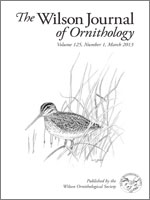We studied the breeding biology of the Straight-billed Woodcreeper (Dendroplex picus) (Dendrocolaptinae) from eight nests in Hato Masaguaral, Venezuela and reviewed current literature for all woodcreeper species. Straight-billed Woodcreepers nested in PVC nest-boxes (n = 6) and in wooden fence posts (n = 2). Mean ± SE clutch size was 2.50 ± 0.19 eggs (n = 8) and egg mass was 5.41 ± 0.12 g (n = 17). Egg mass and clutch mass represented 12.4% and 31% of adult mass, respectively. Both males and females incubated, but average incubation nest attentiveness (percent of time on the nest) was only 63.2 ± 8.2% (n = 8). The relatively low nest attentiveness was associated with an incubation period of 17 days (n = 1). The nestling period was 17–18 days (n = 2), and both parents provisioned the young. Nestling growth rate constants (K) for mass, tarsus, and wing chord were 0.45 ± 0.04, 0.34 ± 0.03, and 0.27 ± 0.02, respectively. Three of eight nests were successful and five were lost to predation. Comparisons with other woodcreepers for many traits are difficult because of limited information. The available information indicates female-only and biparental incubation exists within the Dendrocolaptinae. Our observations of the Straight-billed Woodcreeper add Dendroplex to the genera with biparental incubation.
How to translate text using browser tools
1 March 2013
Breeding Biology of the Straight-Billed Woodcreeper
Ania A. Majewska,
Juan C. Oteyza
ACCESS THE FULL ARTICLE
biparental care
breeding biology
growth rate
Venezuela
woodcreeper





